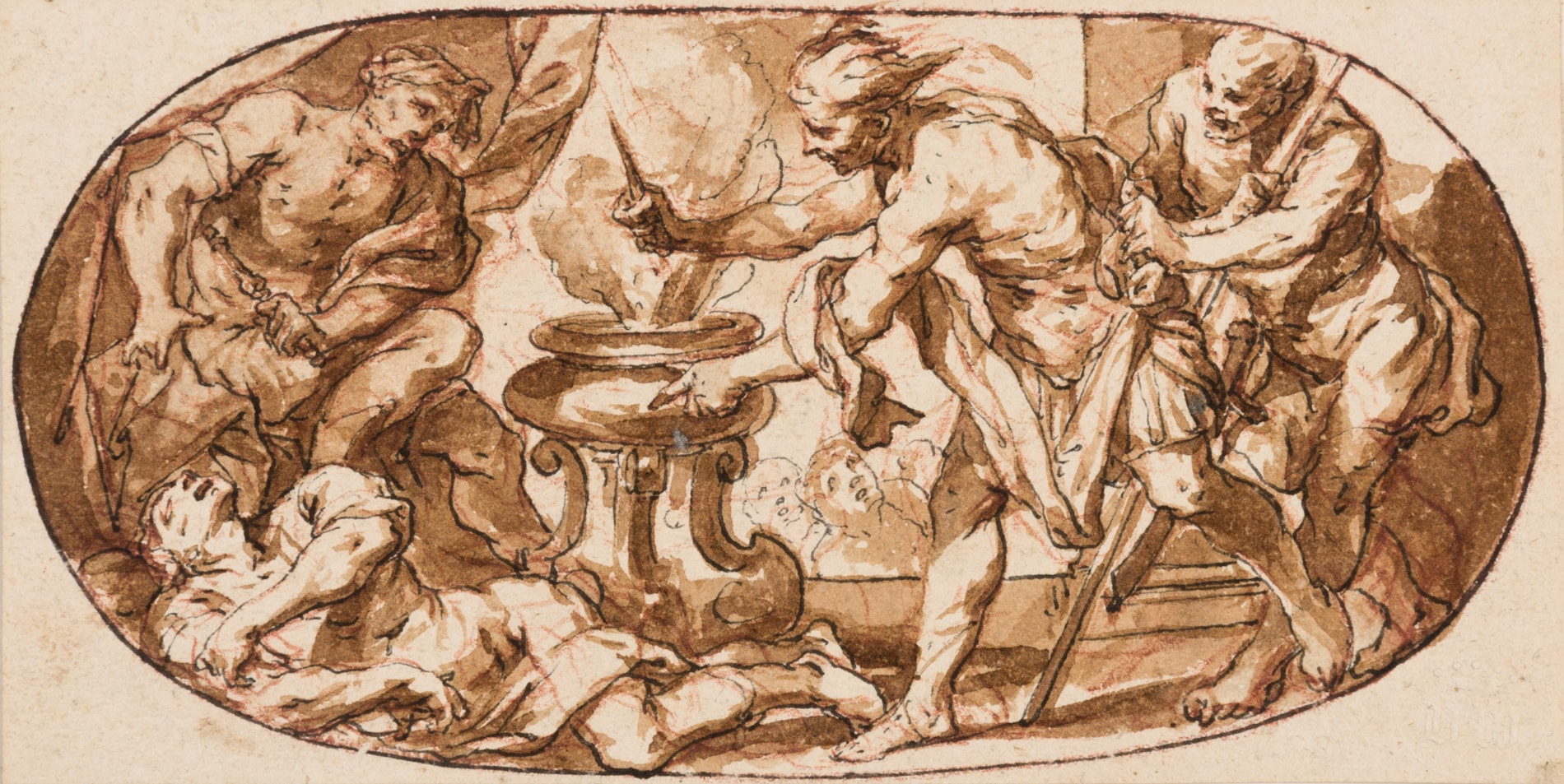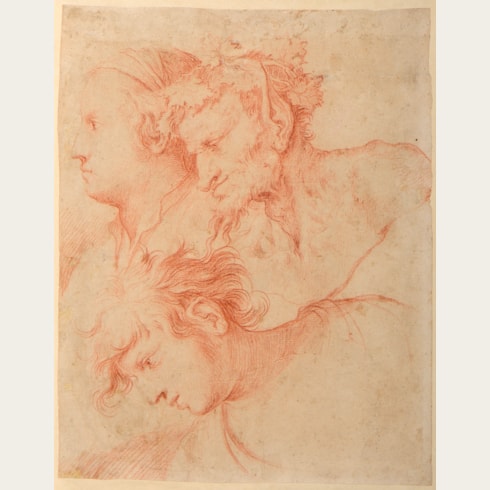17th Century NEAPOLITAN SCHOOL
Mucius Scaevola Before Lars Porsena
Sold
Pen and brown ink and brown wash, over an underdrawing in red chalk.
Framing lines in brown ink. Oval.
Inscribed Die Beherzeit von Mutius Scirevola. on the verso.
Inscribed Mutius Scevola. / Esquisse de Solimene. on the old mount.
Numbered 16 and inscribed F. Solimena. Col de Spengler No.308. on the old mount.
Further inscribed Mutius Scirevola im Lager der Porsena. van Solimene on the reverse of the old mount.
82 x 163 mm. (3 1/4 x 6 3/8 in.)
Framing lines in brown ink. Oval.
Inscribed Die Beherzeit von Mutius Scirevola. on the verso.
Inscribed Mutius Scevola. / Esquisse de Solimene. on the old mount.
Numbered 16 and inscribed F. Solimena. Col de Spengler No.308. on the old mount.
Further inscribed Mutius Scirevola im Lager der Porsena. van Solimene on the reverse of the old mount.
82 x 163 mm. (3 1/4 x 6 3/8 in.)
The story of the bravery of the ancient Roman hero Gaius Mucius Scaevola, taken from Livy’s History of Rome, is one that was long popular with artists. In 508 BC, during the war between the Romans and the Etruscans, the city of Rome was besieged by Lars Porsena, king of the powerful Etruscan city of Clusium. The Roman youth Gaius Mucius Cordius, with the approval of the Senate, volunteered to steal into the Etruscan camp to assassinate Porsena. After killing the king’s scribe in error, Cordius was captured and led before Porsena.
As Livy recounts, the Roman stood before the king and famously declared, ‘“I am a Roman citizen,” he cried; “men call me Gaius Mucius. I am your enemy, and as an enemy I would have slain you; I can die as resolutely as I could kill: both to do and to endure valiantly is the Roman way. Nor am I the only one to carry this resolution against you: behind me is a long line of men who are seeking the same honour. Gird yourself therefore, if you think it worth your while, for a struggle in which you must fight for your life from hour to hour with an armed foe always at your door. Such is the war we, the Roman youths, declare on you. Fear no serried ranks, no battle; it will be between yourself alone and a single enemy at a time.”
The king, at once hot with resentment and aghast at his danger, angrily ordered the prisoner to be flung into the flames unless he should at once divulge the plot with which he so obscurely threatened him. Whereupon Mucius, exclaiming, “Look, that you may see how cheap they hold their bodies whose eyes are fixed upon renown!” thrust his hand into the fire that was kindled for the sacrifice. When he allowed his hand to burn as if his spirit were unconscious of sensation, the king was almost beside himself with wonder. He bounded from his seat and bade them remove the young man from the altar. “Do you go free,” he said, “who have dared to harm yourself more than me. I would invoke success upon your valour, were that valour exerted for my country; since that may not be, I release you from the penalties of war and dismiss you scathless and uninjured.”
Then Mucius, as if to requite his generosity, answered, “Since you hold bravery in honour, my gratitude shall afford you the information your threats could not extort: we are three hundred, the foremost youths of Rome, who have conspired to assail you in this fashion. I drew the first lot; the others, in whatever order it falls to them, will attack you, each at his own time, until Fortune shall have delivered you into our hands.”’
Mucius Cordius returned with honour to Rome and earned the cognomen ‘Scaevola’, meaning ‘left-handed’, for himself and his descendants. Lars Porsena, impressed by the bravery displayed by the citizens of Rome, offered peace terms to the city.
The traditional attribution of the present sheet to the leading Neapolitan artist Francesco Solimena (1657-1747) finds some justification in similarities with a handful of vigorously executed compositional drawings by the artist, such as a study of The Death of Virginia in the Musée des Beaux-Arts in Rouen or a drawing of The Battle of the Lapiths and Centaurs recently sold at auction in New York. Stylistic analogies may also be made with a number of pen and wash drawings by Giovanni Battista Beinaschi (1636-1688), such as a drawing of Jacob Uncovers the Well for the Daughters of Laban in the Louvre or Samson Breaks his Shackles in the Albertina. Beinaschi was trained in Rome before arriving in 1664 in Naples, where he worked on numerous fresco commissions.
The first recorded owner of this drawing was the Swiss pastor and art collector Johann Phillip Veith (1758-1833). At the posthumous sale of Veith’s collection in Leipzig in 1835, the drawing was bought by the Danish museum curator and collector Johan Conrad Spengler (1767-1839). Like his father, Spengler served as steward of the Danish Royal Kunstkammer and later helped to establish the Royal Collection of Paintings. From 1819 onwards he built a fine personal collection of drawings, many bought from dealers and auctions in Germany, including a large and significant group of works by Neapolitan artists, many of which he regarded as by Francesco Solimena. (Spengler is known to have visited Naples at the beginning of 1790, and may have acquired many of his Neapolitan drawings at that time.) At the auction of Spengler’s collection, held shortly after his death in 1839, the present sheet was one of around 150 drawings acquired by another Danish collector, Benjamin Wolff (1790-1866), with whose descendants it then remained for nearly 180 years.
As Livy recounts, the Roman stood before the king and famously declared, ‘“I am a Roman citizen,” he cried; “men call me Gaius Mucius. I am your enemy, and as an enemy I would have slain you; I can die as resolutely as I could kill: both to do and to endure valiantly is the Roman way. Nor am I the only one to carry this resolution against you: behind me is a long line of men who are seeking the same honour. Gird yourself therefore, if you think it worth your while, for a struggle in which you must fight for your life from hour to hour with an armed foe always at your door. Such is the war we, the Roman youths, declare on you. Fear no serried ranks, no battle; it will be between yourself alone and a single enemy at a time.”
The king, at once hot with resentment and aghast at his danger, angrily ordered the prisoner to be flung into the flames unless he should at once divulge the plot with which he so obscurely threatened him. Whereupon Mucius, exclaiming, “Look, that you may see how cheap they hold their bodies whose eyes are fixed upon renown!” thrust his hand into the fire that was kindled for the sacrifice. When he allowed his hand to burn as if his spirit were unconscious of sensation, the king was almost beside himself with wonder. He bounded from his seat and bade them remove the young man from the altar. “Do you go free,” he said, “who have dared to harm yourself more than me. I would invoke success upon your valour, were that valour exerted for my country; since that may not be, I release you from the penalties of war and dismiss you scathless and uninjured.”
Then Mucius, as if to requite his generosity, answered, “Since you hold bravery in honour, my gratitude shall afford you the information your threats could not extort: we are three hundred, the foremost youths of Rome, who have conspired to assail you in this fashion. I drew the first lot; the others, in whatever order it falls to them, will attack you, each at his own time, until Fortune shall have delivered you into our hands.”’
Mucius Cordius returned with honour to Rome and earned the cognomen ‘Scaevola’, meaning ‘left-handed’, for himself and his descendants. Lars Porsena, impressed by the bravery displayed by the citizens of Rome, offered peace terms to the city.
The traditional attribution of the present sheet to the leading Neapolitan artist Francesco Solimena (1657-1747) finds some justification in similarities with a handful of vigorously executed compositional drawings by the artist, such as a study of The Death of Virginia in the Musée des Beaux-Arts in Rouen or a drawing of The Battle of the Lapiths and Centaurs recently sold at auction in New York. Stylistic analogies may also be made with a number of pen and wash drawings by Giovanni Battista Beinaschi (1636-1688), such as a drawing of Jacob Uncovers the Well for the Daughters of Laban in the Louvre or Samson Breaks his Shackles in the Albertina. Beinaschi was trained in Rome before arriving in 1664 in Naples, where he worked on numerous fresco commissions.
The first recorded owner of this drawing was the Swiss pastor and art collector Johann Phillip Veith (1758-1833). At the posthumous sale of Veith’s collection in Leipzig in 1835, the drawing was bought by the Danish museum curator and collector Johan Conrad Spengler (1767-1839). Like his father, Spengler served as steward of the Danish Royal Kunstkammer and later helped to establish the Royal Collection of Paintings. From 1819 onwards he built a fine personal collection of drawings, many bought from dealers and auctions in Germany, including a large and significant group of works by Neapolitan artists, many of which he regarded as by Francesco Solimena. (Spengler is known to have visited Naples at the beginning of 1790, and may have acquired many of his Neapolitan drawings at that time.) At the auction of Spengler’s collection, held shortly after his death in 1839, the present sheet was one of around 150 drawings acquired by another Danish collector, Benjamin Wolff (1790-1866), with whose descendants it then remained for nearly 180 years.
Provenance
Johann Wilhelm Veith, Andelfingen and Schaffhausen
His posthumous sale (‘Kunstsammlung der verstorb. Hrn. Antistes und Dekan Veith in Schaffhausen’), Leipzig, Rudolf Weigel, 2 November 1835 onwards, lot 1226 (as Francesco Solimena: ‘Solimena, F…Mutius Scävola die Hand über das Feuer haltend, Composit. von 4 Figuren. Bister. kl. qu. 4.’, bt. Spengler)
Johan Conrad Spengler, Copenhagen (Lugt 1434), his drystamp at the lower left centre
His posthumous sale, Copenhagen, 8 October 1839 onwards, lot 308 (as Francesco Solimena: ‘Solimena, F…Mutius Scaevola présentant la main au feu; composition de quatre figures. A bistre; 8 en trav. Du cab. de Veith.’, bt. Wolff)
Benjamin Wolff, Engelholm, Denmark (Lugt 420), with his drystamp at the lower right
Thence by descent in the Wolff Sneedorf family until 2018.
His posthumous sale (‘Kunstsammlung der verstorb. Hrn. Antistes und Dekan Veith in Schaffhausen’), Leipzig, Rudolf Weigel, 2 November 1835 onwards, lot 1226 (as Francesco Solimena: ‘Solimena, F…Mutius Scävola die Hand über das Feuer haltend, Composit. von 4 Figuren. Bister. kl. qu. 4.’, bt. Spengler)
Johan Conrad Spengler, Copenhagen (Lugt 1434), his drystamp at the lower left centre
His posthumous sale, Copenhagen, 8 October 1839 onwards, lot 308 (as Francesco Solimena: ‘Solimena, F…Mutius Scaevola présentant la main au feu; composition de quatre figures. A bistre; 8 en trav. Du cab. de Veith.’, bt. Wolff)
Benjamin Wolff, Engelholm, Denmark (Lugt 420), with his drystamp at the lower right
Thence by descent in the Wolff Sneedorf family until 2018.





